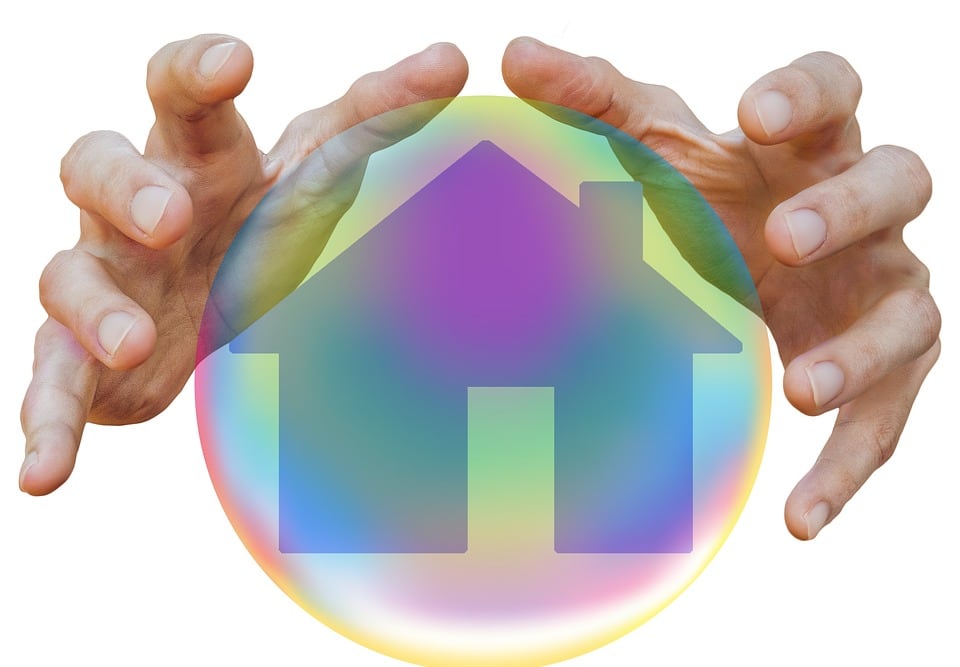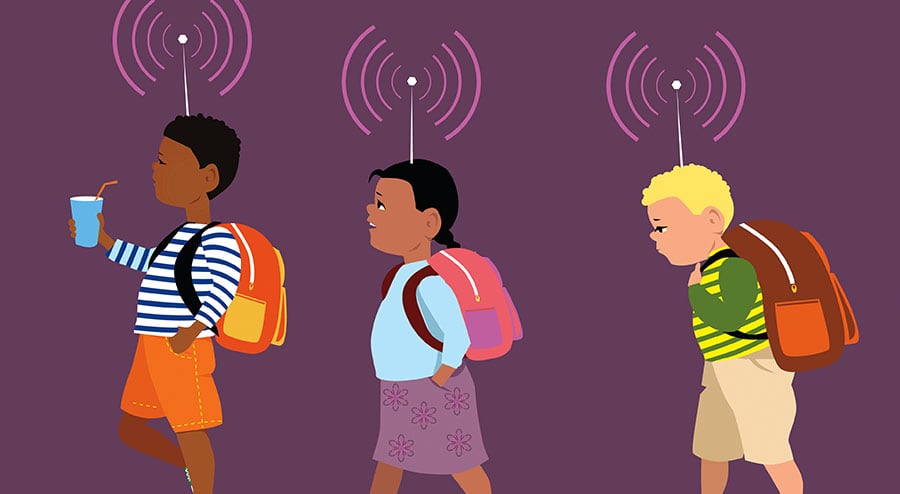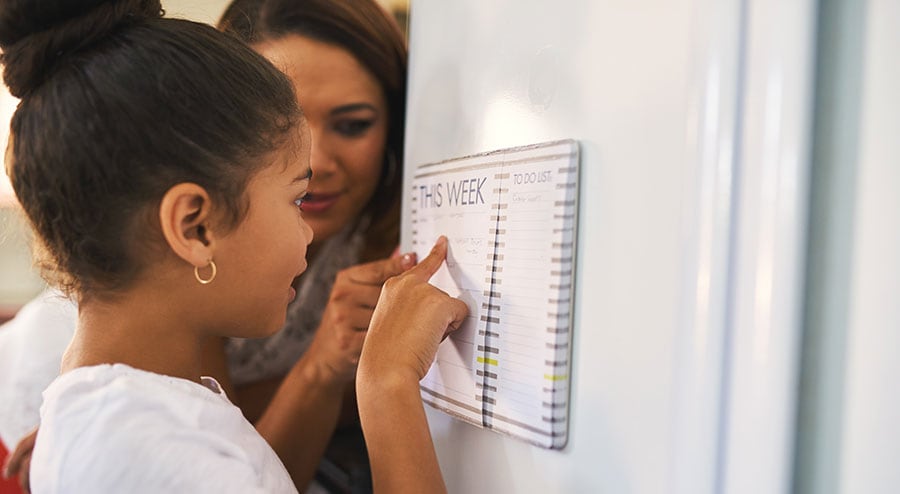Biking is an activity that so many of us do every day on roads, sidewalks, and trails all around the country. Safety may not always be at the forefront of someone’s mind when riding around, seeing as people often bike with places to go, appointments to meet, and people to see. However, being conscious of your surroundings and starting your trip in the safest conditions possible is a great way to help reduce your chances of suffering from injury—or a fatality—when riding a bike. But before we get into the specifics of safety, let’s take a look at how many people bike, why they do, and the advantages of using a bicycle as a main mode of transportation.
How Often Do People Bike?
- Getting to work
- Leisure
- Exercise
- Needing to run errands
- Going to see people
Most people use bikes for exercise or for recreation, according to a 2012 survey. But numbers are steadily rising for people going to work, too. The United States Census Bureau notes that commuters biking to work increased 60 percent from 2000 to around 2012, when 786,000 people reported using their bike to get to work every day. While this is great improvement, this pales in comparison to the overall picture in America, where more than 131 million people commute daily.
Important Stats About Biking To Work
- People bike to work most frequently in the western part of the country and less frequently in the South.
- Men are more likely to bike to work than women.
- The average work commute on a bike is less than 20 minutes.
- Portland, Oregon has the highest rate of residents riding to work (6.1 percent of the city’s population).
Overall, the most common bike rider is a white male. Demographic groups like African Americans, Hispanics, Asian American, and women in general bike less than they are represented in the overall population. For instance, African Americans make up more than 11 percent of the population, but they make up less than 6 percent of all bikers. In addition, women may account for more than half of the population, but they only make up about 25 percent of overall bike trips.
40%
Personal Trips Within 2 Miles of Home
160
Billions Of Dollars In Wasted Fuel Sitting In Traffic
1,000
People Killed Annually In Bike Collisions With Motorists
15%
Biking Trips Used For Work or School
What Are The Advantages of Biking?

Environmental
By biking more and driving less, you can help play a part in reducing your carbon footprint.

Health
Biking has big potential health benefits, from reducing the likelihood of diabetes, to helping you lose weight.

Economic
The Texas A&M Transportation Institute estimated that more than three billion gallons of fuel were used by cars stuck in traffic in 2015, costing more than $160 billion in wasted fuel.
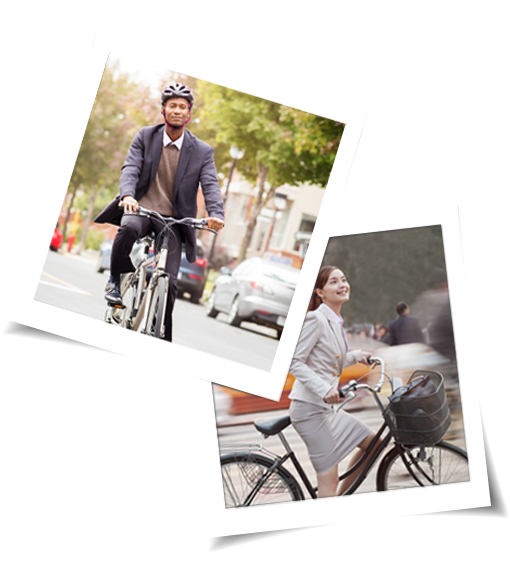
What Are The Advantages of Biking?
Seeing that a small percentage of people use bikes as their mode of transportation during local commutes, it’s important that people understand the slew of benefits that come along with biking to work, the store, and around town. These advantages come in the form of tangible economic savings in addition to environmental and health benefits you may notice over time.
Environmental
The United States has one of the highest rates for personal trips taken by car in the world. More than 85 percent of personal trips—defined as a trip taken for a practical purpose and not for leisure—are taken by car, and that number climbs to more than 90 percent for trips that go directly to and from work. This helps to make the United States the number-two country for carbon emissions—gases that trap heat and aid in the general warming of the environment.
By biking more and driving less, you can help play a part in reducing your carbon footprint—the amount of greenhouse emissions you contribute to the atmosphere based on your daily activity. A national travel survey identified about 40 percent of personal trips were within two miles of the house, which provides an opportunity to bike more within a short and reasonable distance.
One study conducted by the Rails-to-Trails Conservancy (1) found that if overall bike and walking usage increased from 12 percent to 15 percent across America, that could save almost four million gallons of gas from being used, which results in 33 million fewer tons of emissions being released into the environment. Instead of driving to the grocery store to pick up one or two things, you can bike, take a backpack, and bring the items home—perhaps without taking more time than if you drove!
Health
Biking has big potential health benefits, from reducing the likelihood of diabetes, to helping you lose weight. You can also help yourself lower stress levels and improve your overall happiness. Let’s take a look at some of the ways biking can be beneficial for your health:
- Increasing how much you bike (or walk) from four minutes a day up to 22 minutes—quantified in biking as a couple miles to work and back—can help reduce your chance of developing cardiovascular disease or diabetes by 14 percent. According to a study by the National Center for Biotechnology Information (NCBI) (2), walking and biking places more can also reduce the burden of causing a traffic injury by 40 percent.
- Biking is seen as a preventative action in helping fight chronic diseases like obesity and diabetes by the U.S. Centers for Disease Control and Prevention. The Affordable Care Act also set aside money to help improve biking conditions in major cities.
- Despite the common assumption that bicyclists have the opportunity to breath in more air—and thus more pollution—than people inside cars with the windows up, another NCBI study conducted in the 1990s (3) found that motorists end up inhaling 60 percent more pollutants and carbon monoxide than people on bicycles.
- During the 1996 Olympics in Atlanta, when traffic restrictions were put on and people drove around the city less, ozone pollution and hospitalizations rates due to asthma attacks both decreased (4).
- Exercising (including biking) has been shown to help with your mental health. It can reduce stress and have similar effects to meditation and relaxing, according to a study in 2000.
- All the exercising from biking can help you increase your stamina, control your heart rate, and increase muscle, too.
- In Portland, Oregon, there’s a “regional trail system” set up for bikers and walkers that connects many of the cities’ cultural and business centers. This allows bikers to travel the city with the reduced fear of encountering injury due to motorists. In 2011, the city estimated the trail system helped its civilians save more than $115 million in medical costs.
There is room for improvement when it comes to people biking to work and school. A 2012 survey found that less than 15 percent of biking trips were used for work/school purposes. Most were done for exercise and leisure. If you’re concerned about the potential of an injury while riding a bike on the road, international studies have shown that the more people bike in a city, the less likely you are to suffer from a injury on the roadway (5). This is chalked up to there being fewer motorists on the road and the fact that motorists act differently (i.e. safer and more aware) when there are more bicyclists on the road.
Economic
Biking can also have a great economic impact, from the national scale to your wallet. Millions of Americans spend hours and hours of time idling in traffic every year, which wastes billions of dollars on billions of gallons of fuel. The Texas A&M Transportation Institute estimated that more than three billion gallons of fuel were used by cars stuck in traffic in 2015, costing more than $160 billion in wasted fuel. These numbers could drop as more people start to bike to work, especially in congested cities. Simply put, the more you bike, the less money you’re spending on gas!
On a more regional and citywide economic impact scale, let’s look to a study from Copenhagen, Denmark, a city where 45 percent of residents bike to work or school. It was found that for every kilometer a person biked, the city economy was able to save money because of a decrease in time stuck in traffic, lost wages, and the harmful effects cars have on the atmosphere, among other factors.
Finally, and maybe the most obvious point: riding bikes adds to local economies. Riding a bike requires buying one, which requires maintenance, visits to local shops, and easier and smoother access to local communities. Providing access to bikes for tourists also helps boost local economies (6), as it’s been shown that people are encouraged to spend more money and time inside the city while riding bikes around.
Important Bike Safety Tips
Once you decide to hop on a bike, it’s imperative you stay aware of your surroundings while also maintaining proper riding techniques that take into account your fellow pedestrians and motorists. Nearly 1,000 people are killed on bicycles every year due to collisions with motorists.
Here are some tips to follow when riding your bike around town:
- Wear A Helmet: No matter your age, you should always wear a helmet when riding a bike. More than 80 percent of people who die on bicycles are over the age of 16 (often the cutoff for helmet requirements in many states). In addition, 85 percent of deaths on a bike are due to a head injury. Why wouldn’t you want to wear something that serves to protect your head? While a helmet doesn’t protect your whole head, the most important part—your brain—is usually completely covered with hard protective plastic in case of a fall. Make sure the helmet you choose sits evenly just above your ears, covers most of your forehead, and is comfortable (seeing as you’ll be wearing it whenever you bike!).
- Don’t Ride Against Traffic: When riding on the road, it’s imperative that you go with traffic—not against it. This allows motorists to see cyclists on the road from a further distance, rather than someone speeding directly toward them. Bike lanes (discussed soon) flow with traffic on the side of the road, too.
- Use Hand Signals: It’s not easy to be heard when on a bike. Traffic and noise inside cars can drown out the voice of someone riding on a bike, especially as your voice carries forward. You shouldn’t have to yell back at cars to let them know what you’re doing. Bikes typically don’t have directional flickers, either, so it’s best to use hand signals to let cars around you know what you’re doing. The National Highway Traffic Safety Administration says common hand signals include: sticking your left arm straight out, parallel to the ground to indicate you’re turning left; putting your left arm upward at a 90-degree angle (or your right arm straight out, if you’re comfortable with it) to indicate a right turn; and your left arm facing down at a 90-degree angle to indicate you’re slowing down.
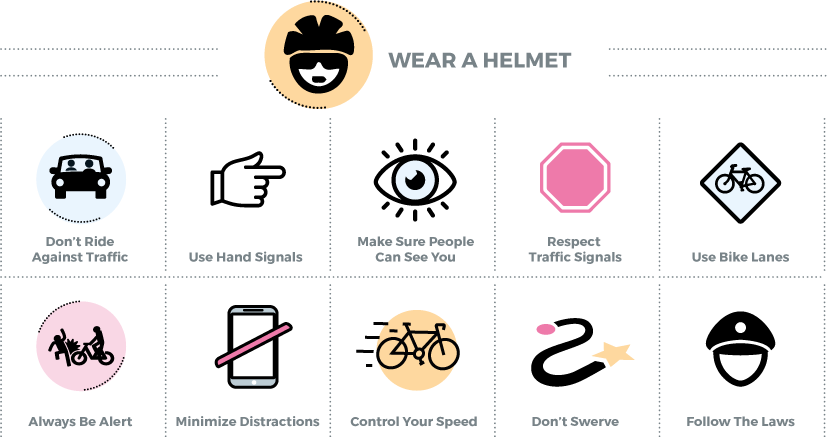
- Make Sure People Can See You: An important part of maintaining safety on a bike is being as visible as possible. This means wearing bright, reflective clothes at night, and having front and back lights on your bike so people can see you coming. There’s even a debate that you should wear bike lights during the day, too (7). You also shouldn’t be weaving between lanes or riding directly behind other cars and trucks, as you may be in their blind spot. Part of being visible is also being heard. Ride with a bell so you can let pedestrians, cyclists, and motorists know you’re coming up behind them.
- Respect Traffic Signals: When you are a bicyclist on the road, you must follow the same rules as cars regarding traffic signals. This means making full stops, looking both ways, waiting your turn at four-way stops, slowing down at yellow lights, and waiting at red lights.
- Use Bike Lanes: Not all cities have designated bike lanes, but be sure to use them when you can. Bike lanes are your friend. They are there to set up a spot where you can safely ride on the roadway, allow cars to pass you at a safe distance, and give you a lane with the right of way. The National Association of City Transportation Officials says that these lanes are typically designated by “striping, signage, and pavement markings” that let motorists and cyclists know which lanes belong to cyclists. They’re most often on the right side of the road alongside a curb or curbside parking, with right turning lanes occasionally crossing paths with them.
- Always Be Alert: There is no time to let up when you’re riding a bike. Just like driving a car, riding a bike on the road or sidewalk (if that’s allowed in your city, though it’s not typical unless you’re a minor) isn’t a time to daydream or appreciate the views of your city, especially with the minimized protection when you’re riding a bike. You must always pay attention to what’s ahead of you (and even behind you) for certain obstacles like other cars and pedestrians, turns, lights, and possible blockades like people getting out of their cars and construction.
- Minimize Distractions: Related to the last tip, part of staying alert is minimizing distractions around you. Try to avoid wearing headphones and listening to music when riding, particularly music at a loud volume that may mask the noise of traffic. If you absolutely need to have headphones in, keep the volume low so you can still hear everything around you. Also, don’t text or talk on the phone and use one hand while riding. You shouldn’t do that when driving a car, so don’t do it on a bike.
- Control Your Speed: Maintaining proper speed is a pivotal part of being safe on the roadway. While the bike speed limit isn’t the same as a car’s speed limit, for obvious reasons, it’s important you don’t go too slow to help the safety of others trying to pass you on the road or in the bike lane. But going too fast is even more dangerous. Cars on the road can make unexpected turns without signaling, people can walk into the roadway, and potholes and sewage grates can come up quicker than expected if you’re going too fast. Also, your brakes may be rendered useless if you don’t have enough time to stop. There’s a happy medium to be found that allows you to move along swiftly with traffic and also stop with short notice if needed.
- Don’t Swerve: When you’re riding on the roadway, it’s important that you don’t swerve. Riding a bike on a public road isn’t a game; you should be acting like a car when on the roadways. This includes staying in your lane, indicating when you’re switching lanes or making a turn, driving in a straight line, going the proper speed in your lane, and respecting a healthy distance between you and another car or cyclist.
- Follow The Laws: There are laws in each jurisdiction to ensure the safety of both bicyclists and motorists who interact on the roadways all the time. Every city and state has different bike laws. For instance, some states require a helmet when you’re riding no matter your age, but some only require a helmet below a certain age. In any case, you should always wear a helmet, especially in heavy traffic areas. Some cities also require that you register your bike, just in case you lose it.
For each state’s bike laws, visit this website.
In addition to you being as safe as you can while you’re actually riding around, there are steps you can take beforehand to maximize safety on the roadway.
Keeping Your Bike Safe
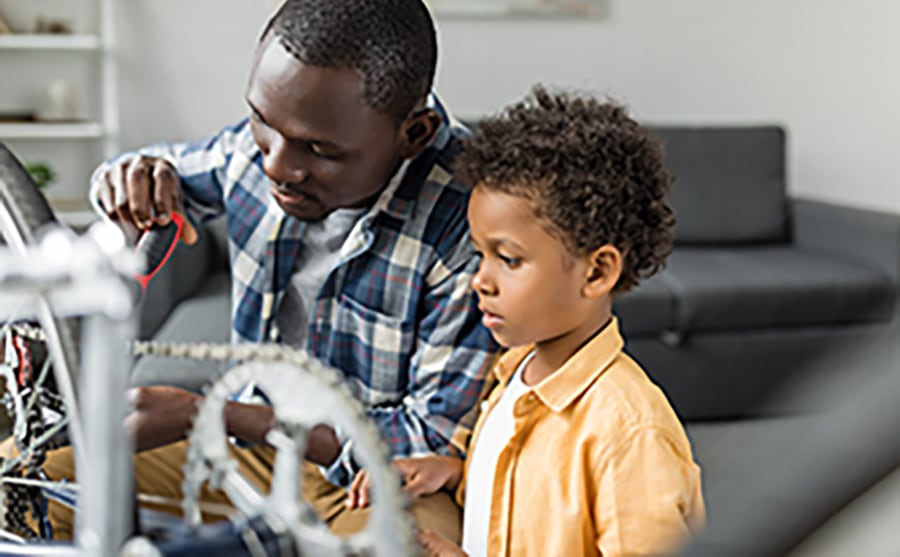
Bike safety begins well before you even get on your bicycle. While staying attentive on the road and following the laws of the roadway are of utmost importance, it’s equally important that you and your bike are safe to ride on the road. Some steps you can take to make sure you’re comfortably riding a safe bike include:
- Get The Right Bike For You: There’s no sense in trying to be as safe as possible on a bike if you don’t have the right one for your body type and riding style. For instance, there are many different types of bikes, such as fixed-gear (the wheels and pedals turn in a rhythm), freewheel (your feet don’t push the pedals but you coast and gradually slow down until you start pedaling again), and touring bikes (designed to help carry luggage). You also have to take into account how heavy or light of a bike you want, the type of handlebars you prefer, and if you want gears or a single-speed bike. You also have to make sure the bike and its frame are the right size, with the correct amount of width between you and the handlebars.
- Get A Comfortable Helmet: The helmet is a large part of being comfortable on a bike. They come in different shapes, sizes, and styles to fit any head. The helmet should cover most of your forehead, and should be secure so it doesn’t move if it’s hit. A good check to see if your helmet is on right is to make sure there’s no space between your temples and helmet. Also, the strap should be secured tightly under your chin.
- Adjust Your Seat: When sitting on your bike, place your heel on a pedal, and put it at its lowest position. Your leg should be fully extended on this pedal. If your knee is bent, you should lift your seat. If you find your foot on its toes trying to reach the pedal at its lowest point, lower the seat. When you’re riding, there shouldn’t be more than a slight bend in the knee when the pedal reaches its lowest point. Having the right seat height helps to make sure that you’re using your body efficiently when pressing down on the pedals.
- Plan Your Route: You should know where you’re going before you even start riding your bike, especially if you’re new to a city or going somewhere you’ve never been. It’s easy to be more comfortable when traveling to a place you frequent often, such as your workplace, so planning the exact route ahead of time for a new destination can help ease the stress of encountering new roadways and road blocks. If you plan on going to a biking trail, know exactly how you’re going to get there and all the safe places to stop. You should also be aware of the furthest points along the route so you know when to turn back if you feel yourself getting tired.
- Secure Your Bike: You can’t ride your bike if you don’t have one anymore! You should lock your bike with a sturdy, heavy lock when you are leaving your bike unattended, even if it’s just inside the store for a couple moments. Be sure to always leave it in a spot that’s visible. This means on bike racks with other bikes, and down certain alleyways or back roads. Someone may seize an opportunity and ride away with it if the opportunity is found. This is also why you should register your bike in a city where they have a registry to keep track of stolen and found bikes. (It may be the law in the city to register it anyway.) When you’re not riding, you should store your bike in a cool, dry environment (inside your home or in a garage) to avoid rusting. Refrain from leaving your bike outside. If you have limited space inside, there are wall mounts you can buy so your bike doesn’t take up any floor space.
The most important and final pre-cycling safety tip you can follow is to run a safety check on your bike before you hop on. The Canadian Automobile Association offers an acronym for you to remember certain safety points to hit before riding: ABC. This stands for:
- Air: Make sure your tires have enough air in them and aren’t leaking. If you find a leak, get a tire fixed. There are patch kits you can keep at home that allow you to permanently fix the problem or at least temporarily fix it until you can get to a bike shop. If your tires are low on air, fill them up by using your own personal air pump or a pump at a local shop.
- Brakes: Roll your bike along the sidewalk and make sure both brakes—front and back—are working properly and smoothly. Inspect them for wear and tear, and replace them when you notice too much squeaking or if they’re losing their effectiveness. (They may just need to be cleaned, but if you’re uncertain, get a professional opinion.) The “B” in this acronym can also stand for “bell” and “bars.” Make sure your bell is working and that your handlebars are properly aligned and at the right height.
- Chain: The last step includes checking your chain to make sure it is lubricated and operating smoothly. This can be done by simply walking the bike down the sidewalk quickly to make sure the chain doesn’t slip off the gears. You can also run your bike through many of its gears (if your bike has them) to make sure the transition is smooth.
Safety should be your number one goal when riding a bike. If you notice any problems with your bike, refrain from riding it on the roadway until you can get it checked out and fixed by a professional.
Sources
- https://www.railstotrails.org/resource-library/resources/active-transportation-for-america
- https://www.ncbi.nlm.nih.gov/pubmed/23409903
- https://www.ncbi.nlm.nih.gov/pubmed/7591177
- https://jamanetwork.com/journals/jama/fullarticle/193572
- https://www.sciencedaily.com/releases/2008/09/080903112034.htm
- http://atfiles.org/files/pdf/NCbikeinvest.pdf
- https://roadcyclinguk.com/gear/gear-features/six-reasons-use-bike-lights-daytime.html


